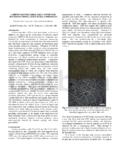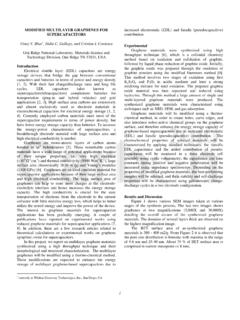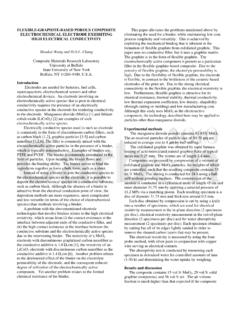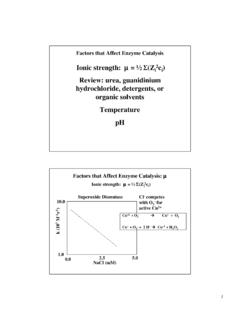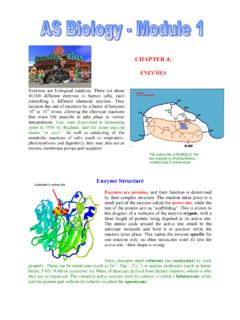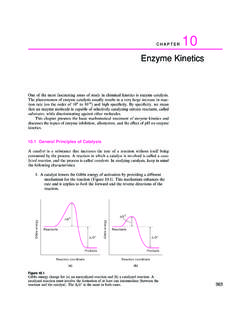Transcription of 2010: NANOTOXICOLOGY: DEPLETION OF ANTIOXIDANTS …
1 1 nanotoxicology : DEPLETION OF ANTIOXIDANTS BY heterogeneous catalysis ON carbon surfaces Xinyuan Liu1, Sujat Sen1, Indrek Kulaots1, David Geohegan2, Alex Puretzky2, Tayhas Palmore1, Agnes Kane1, and Robert Hurt1 1 Brown University, Providence, RI, 02912, 2 Oak Ridge National Laboratory, Oak Ridge, TN 37831 Introduction Recent studies suggest that oxidative stress is one of the main toxicity mechanisms for nanomaterials, and it refers to a state in which reactive oxygen species (ROS) overwhelm the natural antioxidant defenses, such as glutathione (GSH)
2 , and induce oxidative damage on lipids, proteins, and DNA [1]. GSH, a tri-peptide (g glutamylcysteinylglycine), is a major antioxidant in human tissues and its intracellular DEPLETION is commonly measured as an oxidative stress marker. When excess ROS are generated, GSH will be depleted and transformed to its oxidized form (GSSG), and an imbalance between the generation and destruction of ROS is induced, In some casesthe antioxidant defenses become overwhelmed, resulting in cell protective or injurious response, such as airway inflammation and interstitial fibrosis from exposure to ambient particle matter [2, 3].
3 Previous reports have shown that carbon nanotubes can induce oxidative stress and pro-inflammatory responses following exposure of potential target cells. [4]. However, the fundamental mechanism of how carbon nanotubes interact with biological molecules GSH is still unclear as carbon materials are not themselves intrinsic oxidants. Here we studied the interactions between physiological antioxidant GSH and carbon nanotubes in physiological buffers, focused on the role of carbon surface and oxygen, and proposed a possible reaction mechanism for the catalytic oxidation of glutathione through graphenic carbon nanotube surface.
4 Experimental In a typical experiment, 4mM reduced glutathione was added to mg/ml carbon nanotubes suspended in PBS buffer or deoxygenated PBS, and the mixture was sonicated for 15min and then agitated for 2hr, after that the suspension was transferred to a ultrafiltration centrifuge tube (3000 NMWL) and subjected to 30min of centrifugation to obtain a clear solution free of suspended solids and then GSH concentrations in filtrate were determined with ThioGlo-1 on SpectraMax M2 using excitation at 379 nm and emission at 513nm.
5 Oxidized glutathione (GSSG) concentration was measured by reducing it to GSH using -NAPDH and glutathione reductase (GR), and then assayed with ThioGlo-1. Kinetics study was performed by agitating different concentration of CNT suspensions ( , and ) with GSH from 1min up to 100 hrs. To investigate the effects of reactive oxygen species, 20unit/ml or 200 unit/ml superoxide dismutase (SOD), catalase or both were added into CNT suspensions with 4mM GSH, and then filtrates were assayed for GSH concentrations.
6 In the electrochemistry study, ITO coated glass deposited with CNTs was used as the working electrode, with an Ag/AgCl reference electrode and carbon felt or platinum gauze as the counter electrode. A 4mM GSH in PBS was used for all the studies and cyclic voltammetry was performed from to + Volts at a scan rate of 10mV/s. Results and Discussion shows that physiological concentration of 4mM GSH is affected by SWNTs in a dose dependent manner using GSH solution with no CNT addition and PBS solution as two negative controls. 1mM hydrogen peroxide was used for positive control, which is known to oxidize GSH to GSSG with a stoichiometry ratio of H2O2/GSH =1/2.
7 Fig. 1b demonstrates that the GSH can be regenerated from its oxidized form of GSSG by addition of reducing reagent NADPH and enzyme glutathione reductase (GR), which provides strong evidence for an oxidation mechanism. Fig 1c shows a kinetic study carried out with SWNTs and 4mM GSH from 1min to 100hrs. The results show that CNTs destroy GSH in a time dependent manner, suggesting that the interaction of GSH and CNT is chemical reaction rather than a simple adsorption with no energy barrier.
8 The first order reaction of -d[GSH]/dt=K*[GSH]*[CNT] (dash line) fits the experimental data well and it yields a rate constant for the CNT/GSH reaction of K = ml/mg-min = ml/m2-min. This reaction was also found to be significantly inhibited in absence of oxygen compared with the reaction in air (Fig. 1d), indicating the essential role of oxygen in this chemical reaction. Fig. 1 a. Effect of SWNT dose on GSH concentration in PBS; b. GSH can be regenerated by reducing agent NADPH and GR; c. Kinetic study of physiological concentration of GSH and SWNTs; d.
9 Oxygen is involved in GSH and CNT reaction. We alsoemployed a group of reference carbon nanomaterials in this study including SWCNTs, MWCNTs, 2carbon black, activated carbon and glassy carbon . From Fig. 2a, when GSH was plotted vs carbon mass dose, it is seen that that nanomaterials of smaller size decrease GSH concentration to a greater degree per given mass than larger size particles. However, when the carbon nanomaterial concentration was expressed as surface area, the GSH concentration curves collapse significantly, forming a universal band that suggests this reaction is common to all or many grapheniccarbon materials ( ).
10 It also emphasizes the important role of carbon nanoparticle surface area in mediating their toxicity and biological reactivity . Fig 2. GSH concentrations after 2hr incubation with different carbon nanomaterials. a. DEPLETION of GSH vs carbon mass dose; b. GSH concentration was plotted vs. surface area. The effect of introducing ROS scavengers into the system is shown in Fig. 3. It is evident that addition of SOD and catalase can effectively inhibit GSH oxidation and the effect was dominant when 200unit/ml of both SOD and catalase were added into the system, suggesting that O2 - and H2O2 areprobably involved in this chemical reaction and contribute to GSH oxidation.
